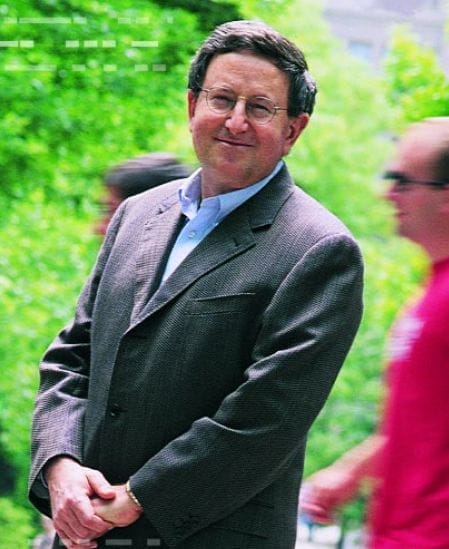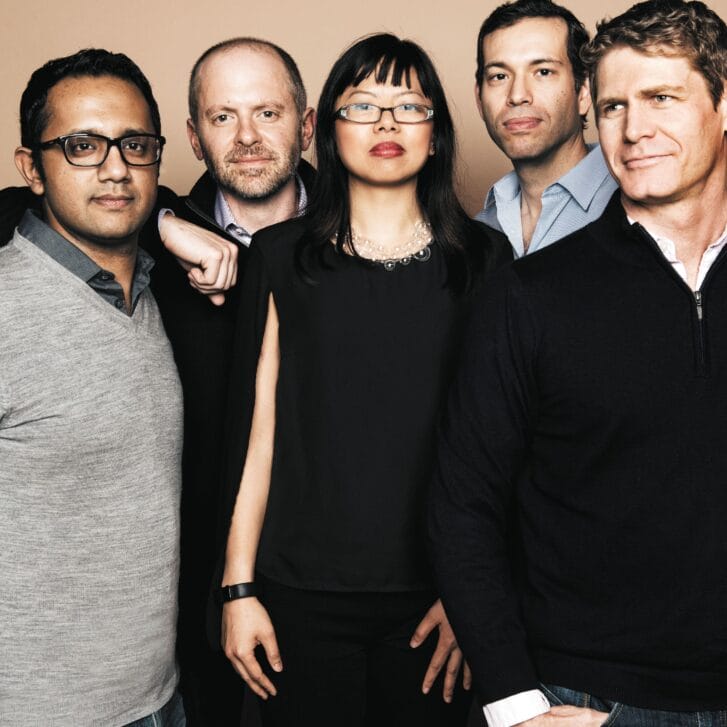Stewart Thornhill thought he was going to have a somewhat relaxing, if outdoorsy, day with his mentor, Raffi Amit. They were headed for Whistler Mountain, the skiing resort close to the University of British Columbia, where Thornhill had studied for his PhD with Amit, for some downhill runs.
“So we go skiing. Raffi really likes to ski,” said Thornhill, who is now teaching at the Richard Ivy School of Business at the University of Western Ontario. “But on the way up on the lift, he insisted on getting down to business with research we were doing.
“That was an introduction to how Raffi works. He’s the ultimate multitasker,” said Thornhill. “He’s one of these people who thrives on not missing anything, on having 20-hour days. If you are not prepared to work until 1 a.m. and get up again at 6 a.m., then you won’t be prepared for Raffi.”
Raphael “Raffi” Amit is the Robert B. Goergen Professor of Entrepreneurship and a professor of management at Wharton. In addition, he is the academic director of Wharton’s Goergen Entrepreneurship Program and a founding director of the Wharton e-Business Initiative (WeBI), the School’s partnership of academics and industry in combining e-business practice with research.
Those two fields are Amit’s core of interest. He sees entrepreneurship and e-business as not only compatible, but essential in today’s business climate.
“E-business is, in fact, business these days,” he said. “There is no business that doesn’t concern itself with one form or another of digital transformation, namely the leveraging of digital technologies to drive performance improvements throughout the enterprise.” He added, “Many established businesses today are going through profound changes led by managers with an entrepreneurial orientation.”
Amit believes that entrepreneurship in both independent and in corporate settings is, despite what has happened with the dot-com crash, “alive and well” and will continue to be a driver of renewal and innovation in businesses.
He said he has noticed that, “The entrepreneurship students in our classes today are no longer the ‘get-rich-fast tire kickers’ but rather students who want to change the world, who are passionate about what they are doing, who are driven by the desire to make a difference. They will win.”
Amit doesn’t get his theories from mere ivory-tower bookishness. He prides himself on being in the field, going to companies and analyzing them from the inside, researching at a basic level. The challenge in entrepreneurship education, he said “is to be able to link theory with practice.” Underscoring this philosophy, he and his colleague, Ian MacMillan, have anchored Wharton’s entrepreneurship initiatives in a solid research program, a comprehensive teaching program, and a broad outreach program.
Some of the entrepreneurship outreach initiatives include the Venture Initiation Program (VIP), the government-sponsored Wharton Small Business Development Center, the Wharton Business Plan Competition, the Enterprising Families Initiative, and an Entrepreneur-in-Residence Program. All of these outreach programs are designed to complement and enhance the basic mission to create and disseminate new knowledge about entrepreneurship.
“He is very much in touch with real-world situations,” said Wharton professorial colleague and former dean Tom Gerrity. “He likes to get out and around, knowing not just the data, but the texture of firms. That is where he differs. Lots of people collect data. Raffi tries to feel out what is really going on in companies and with entrepreneurs.”
Another one of Amit’s students from his University of British Columbia days, Christoph Zott, now an assistant professor of entrepreneurship at INSEAD, the management school in Fontainebleau, France, is doing research with Amit on entrepreneurship and strategy.
“From the first day I was his PhD student, he treated me like a colleague and peer,” said Zott. “He also addresses issues in a frank and direct manner. There is no beating around the bush with him. He gets to the ‘bottom line,’ one of his favorite expressions, very fast.”
“At the same time, he’s flexible and leaves room to adapt and change,” said Zott.
Amit was born and did his early schooling in Israel, obtaining bachelor’s and master’s degrees in economics there. He came to the United States to earn his PhD at the J.L. Kellogg Graduate School of Management at Northwestern University. He taught at Northwestern and the University of British Columbia before coming to Wharton.
But Amit also likes to practice, not just study, business. From 1996 to 2001, he was the non-executive chairman of the board of Creo Products, Inc., a NASDAQ-listed imaging equipment company.
“Wharton is an exciting place, in part because it is such an entrepreneurial organization that embraces innovation,” said Amit, relaxing a bit in his office chair just after spring semester and before a trip to Wharton West. “Very few people have been given the opportunity and the time to think about profound issues that affect business and society and then given the resources to gain a deeper understanding of these issues through research. I feel very fortunate. ”
Amit’s current research is expansive and varied. He is doing the entrepreneurship and strategy research on business models with Zott and another project on bankruptcy with Thornhill. He is also doing research on digital transformation with his Wharton colleagues Morris Cohen and Jerry Wind in a unique collaboration with McKinsey & Co. Amit has recently initiated a new project that centers on NASDAQ-listed companies from around the world.
“It’s not just how they survive, but whether NASDAQ companies survive at all,” he said. “I’m just starting to collect data, and that can be wearing. But data is where it all starts.
“I love data-driven analysis,” said Amit. “First of all, data really does tell a story. In its best form, it is not just numbers, but a story, in this case, of how a company works. Second, when you have enough of it, you can develop and test hypotheses and theories that are grounded in reality.”
One of those theories that Amit is unafraid to posit, despite the dire wailings of those who have been bitten badly by the dot-com collapse, is that e-enabled organizations are a prerequisite for realizing long-term superior financial performance in most industries, old and new.
“I remember not long ago talking to the chief information officer of a utility company,” said Amit. “He compared what we are going through with e-business to the end of the nineteenth century, when the utility grid provided universal electric power and changed society in a profound way.
“I do believe we live in a truly unique time,” he said. “Computing power still doubles every 18 months, making communication and information technology cheap, reliable, and fast. The digital transformation has already started, but it will continue to cause a profound architectural change in our lives. And it was brought about largely by entrepreneurs. We are at the tip of the iceberg.”
One of the reasons Amit thinks the last four years of hype of the Internet is mere prologue is that it was primarily technologists who were doing the touting. It is only in more recent months that CEOs and top managers of incumbent firms realized the enormous potential to drive performance improvements through digitizing core organizational processes.
“Senior managers were resistant at first,” he said. “The demise of many dot-coms has turned off a number of executives.” Only recently, CEOs and top executives have realized the real benefit that can be captured through the digitization of many of the firm’s processes. “You see them all with their personal desk assistants and their Blackberries, monitoring and guiding their diverse companies. The tech guys may have pushed this business, but real change still has to be driven from the top. Unless the top management drives digital transformation, it won’t become part of company culture and fabric,” he said.
Why did this take so long? Amit believes that by examining the pace of adoption of technologies by businesses, it becomes clear that “many had unrealistic expectations in thinking that profound changes can happen in merely six months. It took 15 to 20 years for PCs to be widely adopted by businesses.” Also, Amit thinks it took peer pressure among CEO-types to accelerate the pace of adoption. “When they meet each other at big summits or even at social gatherings, they begin to believe. They see and listen to the experiences of other CEOs with a gadget or an idea and say, ‘Hmmm, maybe I should do that, too’,” said Amit. “That is often what drives big changes.”
While consumers certainly see e-change in their lives – be it with shopping on line, booking travel, or e-banking – it is in the business arena that the change will continue to burgeon, he said.
Amit sees on the horizon more and more large and small firms that will be managed through a digital dashboard. No longer will there be 30-day accounting or inventory control. This information will be at the fingertips of executives. It will enable them to be flexible and responsive to a rapidly changing business environment. Everyone will trade with everyone else at any time, which will require both buyer and seller to know what the state of manufacture and delivery is instantly.
“Our research suggests that consolidation of databases within firms is the foundation for enabling collaboration among firms. The emergence of web services technologies will eventually facilitate interaction among complex information systems of firms which, after overcoming a range of barriers that still exist, will enhance revenues and reduce costs and thereby create value.”
Amit believes that many of the innovations that will eventually change how business is conducted in entire industries are brought to market by entrepreneurs. FreeMarkets, Inc., which operates business-to-business online auctions, is a case in point. Yet other innovations emerge out of collaborations among industry incumbents. One example Amit provides is Covisent. The platform, developed by original equipment manufacturers (OEMs) in the U.S. automotive industry, has standardized the procurement platform for automotive parts and changed procurement practices in the entire industry.
Increased collaboration in the automotive industry, Amit noted, is also driven by Product Data Management (PDM) systems, which will enable, among other things, collaborative designs.
“The introduction of Covisent, along with the growing use of eAuctions by OEMs, has been painful for all suppliers and vendors as they had to change how business is conducted, but it has reduced the transaction costs and has made the market more efficient,” said Amit.
Amit tries to keep his own life efficient. He said he does his best to refine his travel schedule so he moves around a lot and then gets to stay at home for longer periods. He and his wife Ava live in Philadelphia and have two children. Their son, Amos, is 24 and a first-year analyst in the technology investment banking group of a leading investment bank in Northern California. Their daughter, Karen, 23, starts graduate school in the fall.
When he travels, as Thornhill noted, he often enjoys fitting in a mix – either skiing or catamaran sailing or, colleague Zott said, a good meal with his colleagues.
“Raffi was brought up as a child by parents and grandparents who had lived a long time in Germany, so he actually speaks German extremely well, with a Berlin accent, even though he never lived there,” said Zott. “He also appreciates good German traditions, like ‘Kuchen mit Schlagzane’ – cake with whipped cream in the afternoon.”
“It is obvious that Raffi enjoys what he does tremendously. This is why he is so very committed to Wharton, to his research, teaching, and programs he leads,” said Zott.


























